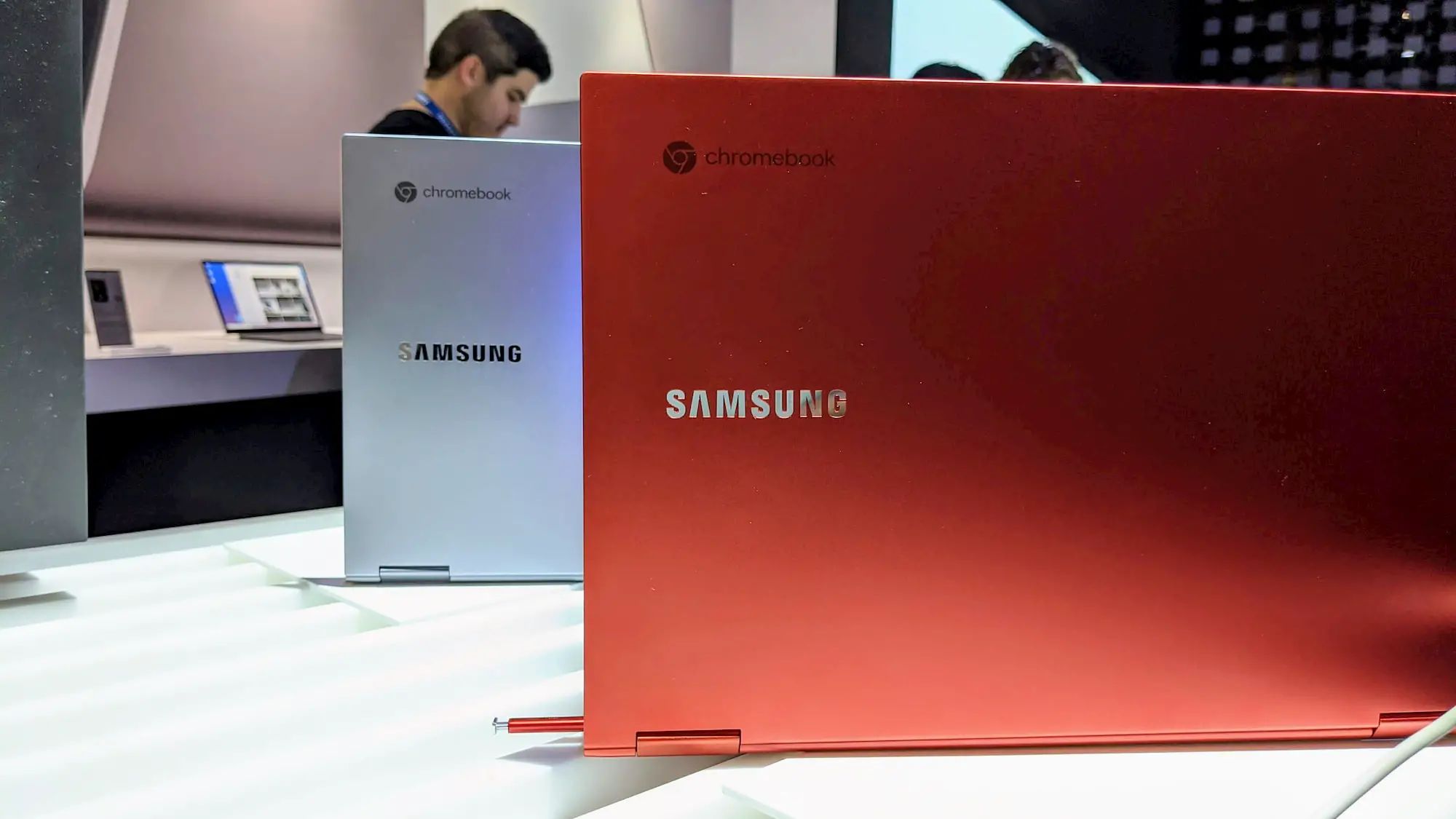The time has come for Samsung to redeem the Galaxy Chromebook
The year was 2020. Three small-town tech bloggers made their way to Las Vegas for what could potentially be the greatest Chromebook reveal in history. Little did we know that three months later we would be smack dab in the throes of a global pandemic but that’s a story for another day. At the time, we were expecting to see a newly iterated Samsung Chromebook Pro V2 and while Samsung did not disappoint, we were greeted with an even greater surprise when we landed in Nevada.
Before CES 2020 had officially kicked off, Samsung and Google had already released news that a Galaxy-branded Chromebook would be on display at the annual trade show. Unlike many a Chromebook unveiling at CES that take place in off-site locations and side rooms away from the “big news” hardware, the Samsung Galaxy Chromebook took center stage in the main hall alongside Samsung’s latest Windows Galaxy Book laptops. This was a very big deal for the Chromebook landscape. Even with ten years of existence under its belt, ChromeOS was still widely viewed as an operating system for children or a glorified web browser that wasn’t capable of much else other than surfing the web.
When we arrived on the show floor, the Samsung booth was a buzz like always and the tables in the main hall where the Galaxy Chromebook was strutting its stuff was overrun with excited tech enthusiasts. Our enthusiasm turned to unbridled excitement as we approached the tablet that held multiple Galaxy Chromebooks in that fiery Fiesta Red and the more subtle Mercury Gray. Once we were able to get our hands on the sleek, magnificently built Galaxy Chromebook, our hopes were fulfilled. Just for a moment, take a look back with me and relive the excitement that was the debut of the Samsung Galaxy Chromebook.
As I mentioned, we were absolutely floored by this new Chromebook from Samsung. The fact that a company that built its name around the Galaxy brand would put that badge on a ChromeOS device was probably the biggest thing to happen to Chromebooks since Android apps arrived on the platform. This laptop screamed Galaxy. Under 10 mm thick, beautifully crafted, and featuring everything that ChromeOS had to offer at the time, this was undoubtedly the greatest Chromebook ever made. Until it wasn’t.
The morning after…
Okay, it wasn’t exactly the morning after. It would be nearly three months before Samsung’s flagship Chromebook would be available to the public. Once it was released in April of 2020, things rapidly deteriorated. Because of the Galaxy Chromebook’s ultra-thin design, Samsung opted to go with a fanless CPU setup using an Intel Core i5 processor. These CPUs, while technically capable of going without a fan, tend to put out a fair amount of heat. It wasn’t long before users took to the web to complain that the bottom of the device was getting uncomfortably hot while lapping the Chromebook. While I personally never experienced this issue, there were enough people complaining about it to concede that it was an issue.
That, sadly, was just the tip of the iceberg. The overarching gripe from reviewers and users alike was the poor battery life of the Galaxy Chromebook. It became such a hot topic that the premium 2-in-1 was being likened to iPhones of old that required you to be tethered to a plug if you planned on getting anything done. The sub-par battery life was due, in part, to the segment-first AMOLED display that the Galaxy was rocking. If you use the Chromebook at less than 50% brightness all the time, battery life wasn’t much worse than any other device but crank it up and you’d be lucky to get 5 hours and that’s just unacceptable for a thousand dollar laptop. Especially in a time when Chromebooks had barely breached that price range in the consumer market.
So, the battery life was bad and some devices were having thermal issues. An unfortunate happenstance but not quite enough to completely demonize this beautiful Chromebook, right? I mean, some firmware updates could improve both of those issues and at one point, it appeared that Samsung was addressing the battery life problem. Sadly, that fix never surfaced and Samsung seems content just sweeping the problem under the rug. Strike one.
Then, things really started to fall apart. Reports started surfacing that the Galaxy’s key frame and track pad were beginning to fail. Missed keystrokes, double-typed spaces/keys, and even the track pad not working entirely. Some users even reported audio issues where the speakers randomly stopped working for brief periods and then began working again with no rhyme or reason. We soon found this out first hand after we bought a brand new Galaxy Chromebook for one of our staff writes directly from Samsung. It is extremely difficult to be productive as a full-time writer when your keyboard isn’t working properly. Strike two.
I contacted Samsung to start a repair order and I was given a shipping label to send the Chromebook to an authorized repair partner. Okay. So far, so good. A few days later, the Chromebook was returned and everything seemed hunky-dory. Keep in mind, this Chromebook was less than six months old to us at the time. Soon enough, the same issues emerged. I proceeded to contact Samsung to request a refund or exchange and was told that the company was not accepting returns on the Galaxy Chromebook. Even though it was well within warranty, our only option was sending it off for yet another repair attempt. Bad form Samsung. It was obvious that this issue was plaguing multiple Galaxy Chromebooks. Why not make good and issue a refund or at least replace the device and try again? Anyway, the refusal to replace or refund our purchase was a fail in my humble opinion. Strike three.
It was clear to me that Samsung had chalked up its losses and that the Galaxy Chromebook would forever be known as the laptop that “could have been.” Then, Samsung threw a curve ball by releasing the Galaxy Chromebook 2, a dumbed down version of the original Galaxy. While the second iteration avoided all the bugs that plagued the original Galaxy Chromebook, it was a blasé device with too much plastic and an overall lackluster look and feel. If you can grab one on sale, it’s a solid device with a little curb appeal but it simply doesn’t have the fit and finish that we originally saw from the OG Galaxy Chromebook.
From there, Samsung decided to start producing budget-friendly devices that still bore the Galaxy name and that felt like an absolute punch in the gut. With each new device, we were left wondering if Samsung would ever take another swing at the ultra-premium market. I mean, the company’s Galaxy Book devices are absolutely amazing. Everything about them exudes premium power and performance. It’s clear that Samsung knows how to make a great laptop. So, why not learn from their mistakes and give it another go?
It is time
Samsung has never been a giant in the Chromebook space but the company has been there from the very beginning. The electronics giant has been responsible for some of the most exciting and innovative ChromeOS devices on the market. Its deep ties with Google have left me wondering why Samsung has all but abandoned making another flagship device. Now, we have companies like HP releasing “prosumer” Chromebooks that are designed to compete with even the nicest PC and Apple devices available. The iron is hot and Samsung has a prime opportunity to strike.
The thing is, Samsung doesn’t have to reinvent the wheel. The original Galaxy Chromebook is, to this day, one of the best looking, uniquely designed Chromebooks ever made. The big issues with the Chromebook could easily be circumvented by making it a tad thicker, adding a fan, and using the same key frames and track pads found in the Galaxy Book Windows devices. That’s it. Forgo the AMOLED display and use a crispy 2K panel and the battery life issues all but take care of themselves. Keep the garaged stylus and make it USI. Seriously, that’s all this device needs to experience a full rebirth and redeem Samsung’s first attempt.
The market is finally becoming comfortable with Chromebooks in the $700-$800 price range. Samsung could easily launch a true successor to the Galaxy Chromebook priced at the same $999 and no one would even bat an eye. Frankly, the ChromeOS ecosystem needs a new Galaxy. Google doesn’t appear to have anything on the radar and HP is the only game in town when you’re talking about ultra-premium, consumer-facing Chromebooks. A void has been created and Samsung would do very well to swing in and fill it. That’s just my two cents but I so desperately wanted to root for the Galaxy Chromebook but it fell short. It is time for Samsung to redeem the Galaxy name and give HP a little competition.
Source: Chrome Unboxed


